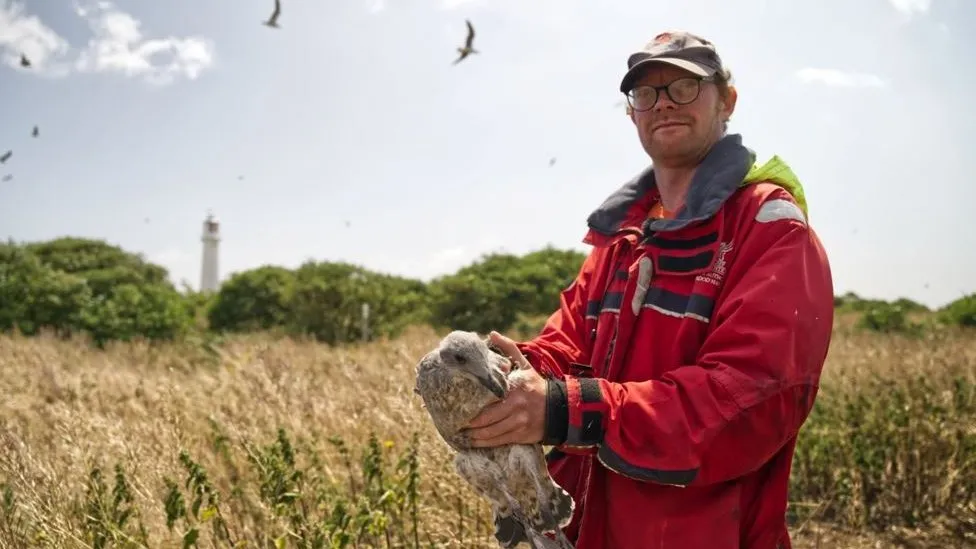A 2012 article titled “Taking refuge from modernity: 21st century hermits” in the Journal of the Rpyal Society of Medicine compares contemporary “hermits” seeking solitary places due to concerns about “electro-hypersensitivity” and “multiple chemical sensitivities” with the motives of historical hermits. Among the former are people fleeing electromagnetic radiation through cell towers and other technology devices. The behaviors and motives are compared to specific historical hermits: Noah John Rondeau, Roger Crab, St. Simeon Stylites, and St, Anthony the Great. The number of historical hermits is small, limited, and perhaps not representative.
Simon Parker, Welsh hermit
BBC News carries this item on the Welsh hermit Simon Parker in an article titled “Flat Holm: The man who lives alone on an island. ” Flat Holm is the name of the island just four miles from Cardiff. From the BBC article:

“Simon has learnt a lot about the island and its wildlife and, perhaps more importantly, something about himself too.
“Being able to walk out my front door and be met with all this noise from the birds gives me boost.
“I know for my own personal wellbeing I need time in nature.
“I’ve always loved being in remote places, although I’m only four miles from Cardiff, sometimes it can seem like a million.”
He said the island was “all or nothing” and urged others to make the jump as well.
“Life is short so I put out to anyone thinking of doing something like this – just to do it,” he said.
“Feed your inner child and you might end up a place like this.”
Dario Escobar, Colombian-born hermit

Colombian media sources (El Tiempo, Noticias Caracol TV, El Colobiano) feature Darío Escobar, Colombian-born priest, who has been living a hermit life in Lebanon’s Qadicha Valley for twenty-three years. Fr. Darío grew up in a wealthy family, surrounded by luxuries — as he himself states — but he renounced all this for the priesthood, and went further — becoming a hermit in a place where he was unknown. The first years of isolation were difficult, but having survived and eked out a routine of prayer and work, he tells journalists that he could never do anything else.
URL: https://www.eltiempo.com/mundo/medio-oriente/la-vida-del-sacerdote-colombiano-ermitano-que-lleva-23-anos-aislado-del-mundo-789886 — El Tiempo; https://noticias.caracoltv.com/mundo/colombiano-ermitano-lleva-23-anos-aislado-del-mundo-aqui-no-hay-telefono-ni-radio-ni-television-rg10 — Noticias Caracol TV; https://www.elcolombiano.com/cultura/la-historia-del-colombiano-que-lleva-23-anos-como-ermitano-completamente-aislado-del-mundo-exterior-PA22004865 — El Colombiano.
“Willard: The Hermit of Gully Lake” (film)

Based on the book The Hermit of Gully Lake: The Life and Times of Willard Kitchener MacDonal, by Joan Baxter, is the 2007 film titled Willard: The Hermit of Gully Lake, produced by APL Films, directed by Amy Goldberg, and narrated by Randy Bachman.
Description (from the film): “In the 1940’s American-born Willard MacDonald jumped his troop train heading to WWII. Fearing authorities he lived as a hermit deep in the northern wilderness of Nova Scotia, Canada for more than 60 years inspiring folklore for generations.” Trailer on Vimeo.
Recent psychology articles
Here is a random list of recent articles on the psychology of solitude. Pychology Today aticles are usually direct and intendedto be practical. Of interest among other articles are points of view highlighting caveats of pursuing solitude without good grounding in self. At the same time, one continues to encounter misconceptions about solitude by standard sources, edging solitude towards loneliness and mental challenge.
From Psychology Today:
“How to Be Alone with Yourself”
URL: https://www.psychologytoday.com/us/blog/the-philosophers-diaries/202107/how-to-be-alone-with-yourself
“Our Major Misconceptions About Loneliness”
URL: https://www.psychologytoday.com/us/blog/curious/202306/correcting-misconceptions-about-loneliness
“How to Enjoy Solitude Without Feeling Lonely”
https://www.psychologytoday.com/us/blog/the-clarity/202307/how-to-enjoy-solitude-without-feeling-lonely“
